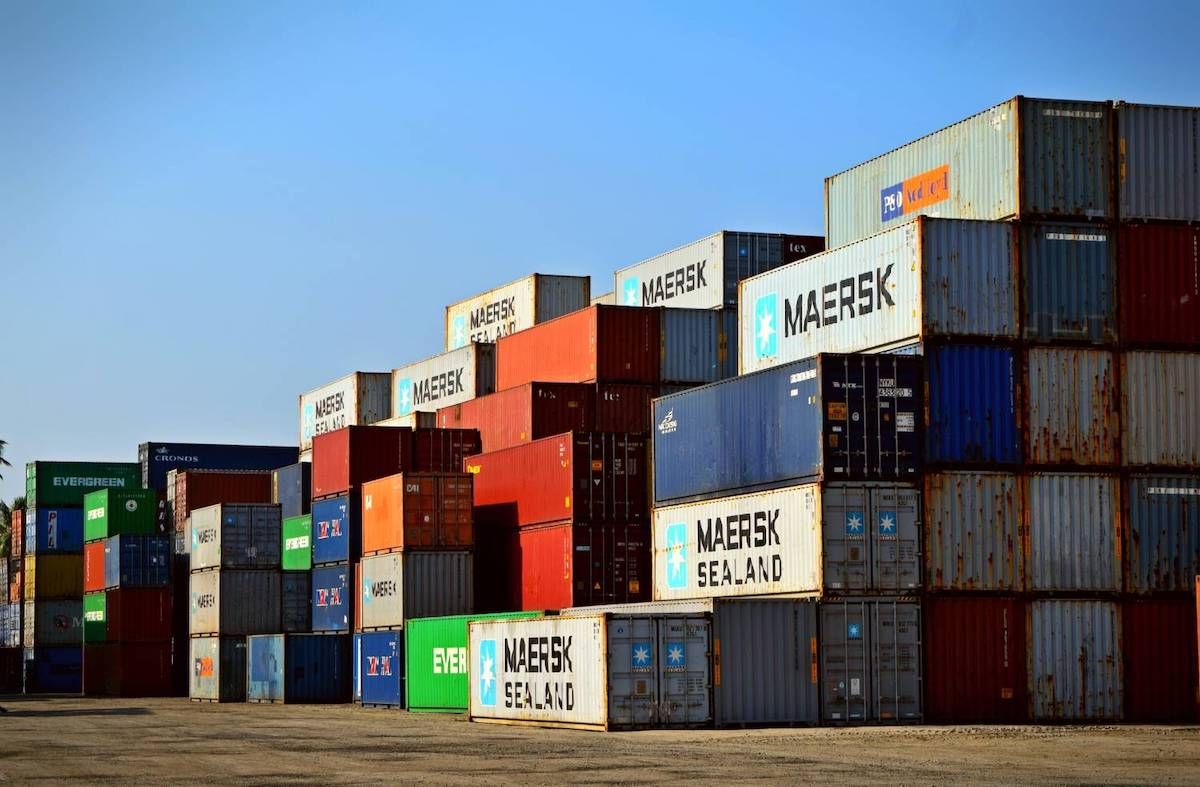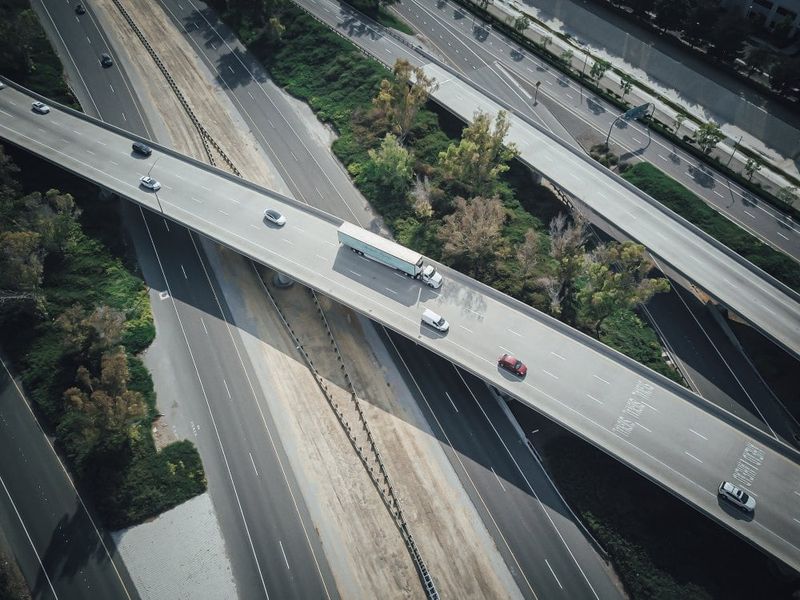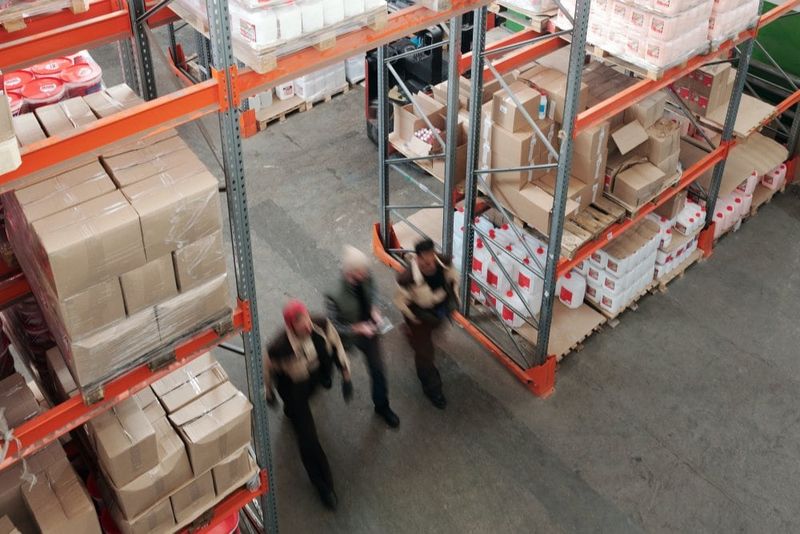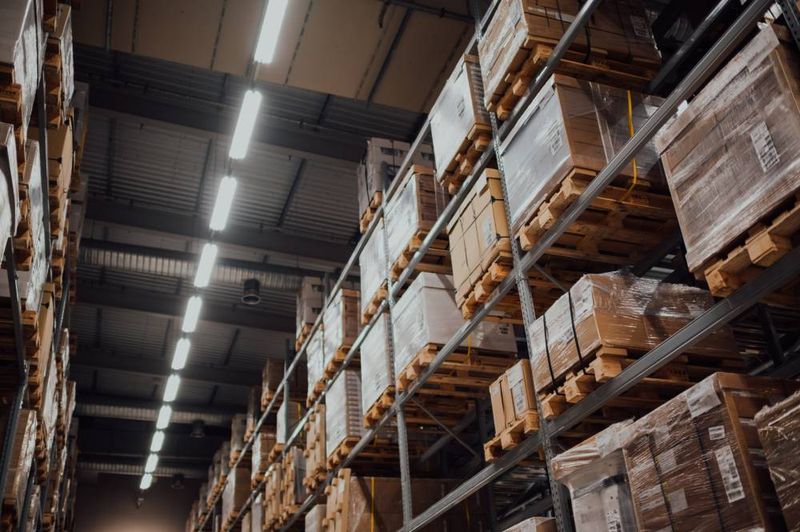- FBA fulfillment programs
- Storage fees with Amazon FBA
- Fulfillment fees with Amazon FBA
- Shipping and Export settings
- FBA customer returns
- Prepare shipment to Amazon
- Hazardous materials
- Monitor Amazon FBA with AMALYTIX
- Conclusion
Fulfillment by Amazon allows Amazon sellers to leverage Amazon's warehouse and shipping network and outsource tasks related to the shipping process. The FBA process looks like this: Selling partners send their items to one of the so-called Amazon Fulfillment Centers (logistics center). Either Amazon stores individual products or the entire inventory of a merchant. If a customer orders a product, Amazon removes the product from the warehouse, packs it, and ships it to the customer. In addition, Amazon provides customer service in the local language and handles customer returns.
In a nutshell: You hand off tasks for handling the shipping process to Amazon, and Amazon handles the entire shipping process from shipping confirmation to handling customer returns.
In this article, you'll get a comprehensive overview of the different fulfillment programs. In addition, we explain how storage costs and shipping costs are made up and how to send shipments to Amazon for Amazon FBA.
FBA fulfillment programs
Amazon offers different FBA fulfillment programs in Seller Central that can be used by Amazon sellers. The programs differ in which countries the goods are stored and the choice of the program has tax implications, e.g. on sales tax.
You have the choice between the programs:
- European Fulfillment Network (EFN)
- Multi-Country Inventory (MCI)
- Central Europe Programme (CEE)
- Pan-European FBA (Pan-EU)
- Small and Light
Under "Settings", click on "Fulfillment by Amazon" to set where your goods should be stored.
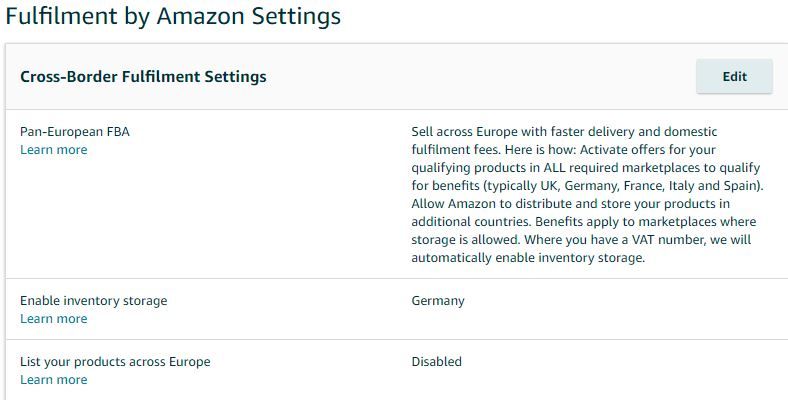
European Fulfillment Network (EFN)
The "European Fulfillment Network" program is the smallest fulfillment program available to Amazon Sellers. You store your goods only within f.e. Germany in different fulfillment centers. Which fulfillment center you need to deliver depends on the item size, weight, sales history, and distance from the nearest fulfillment center. Amazon tells you which fulfillment center you need to deliver your goods to during delivery planning. Although you only store your goods in German fulfillment centers, sales are possible on all European marketplaces. With the European Fulfillment Network, your goods will be shipped from one of the German fulfillment centers to customers in Germany or abroad.
You do not need to activate the program separately. Once you start using FBA, you will have the option to access the EFN network. You can set which countries Amazon should ship your goods to via the "Export settings".
Note that you will have to pay a 0.35 euro chargeback to Amazon per unit sold since you are not using the "Central Europe Programme". In addition, shipping is much more expensive for customers abroad and the shipping time is very long from the customer's point of view abroad.
Thus, the EFN program is mainly suitable for the start of sales on Amazon and if the order quantity per month is less than 1,000 units. The program is ideal if you have mainly a local customer base. Local customers receive their orders via the fastest shipping method and via Prime. Sellers also benefit from low return costs. Return costs refer to the costs incurred when your inventory is either returned to you or disposed of.
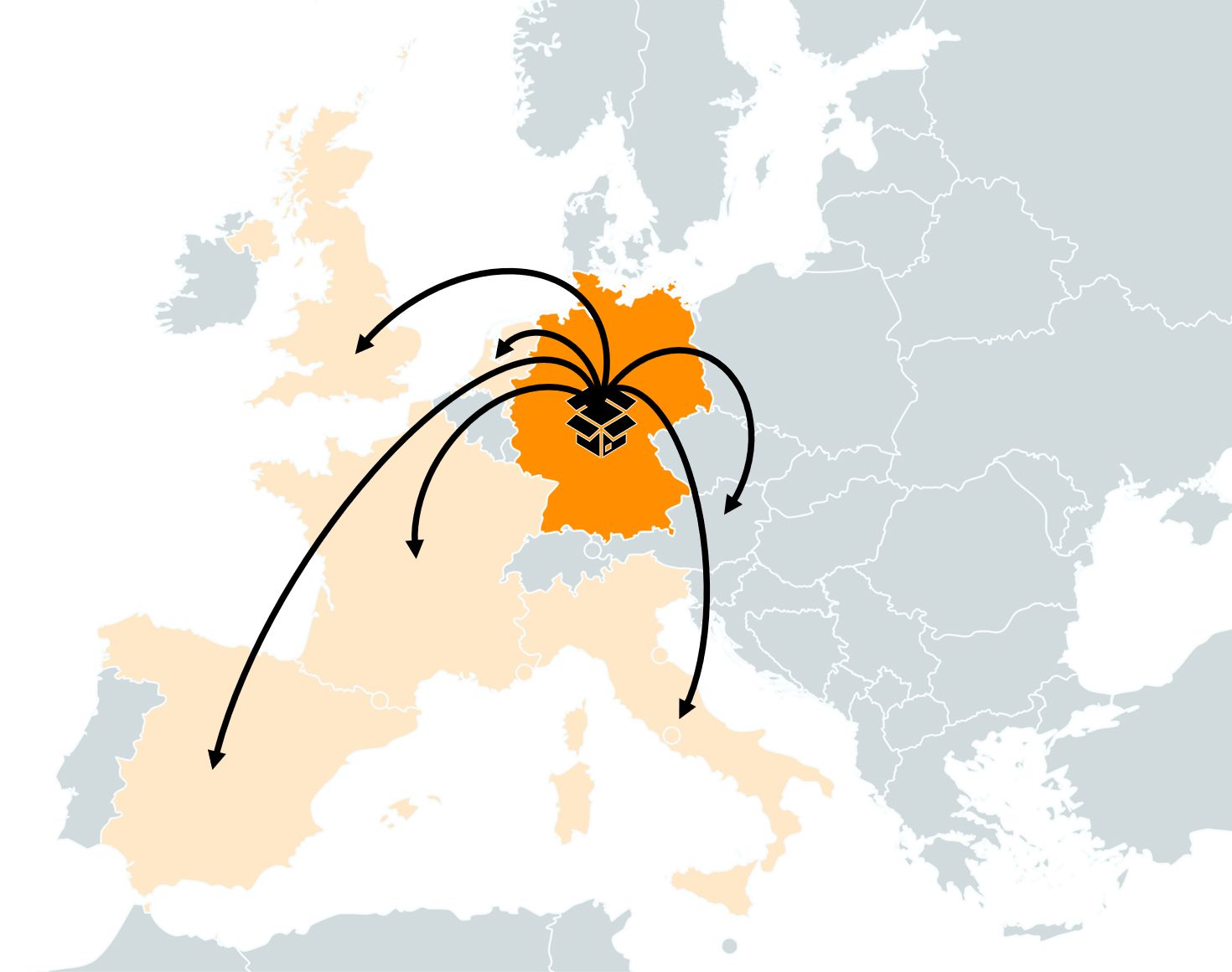
Multi-Country Inventory (MCI)
With the "MCI program" (Multi-Country Inventory) you store your goods not only locally, but also in other European countries. Currently, you can store your goods in France, Italy, Spain, and the Netherlands, but more countries will follow in the future. The goods are not sent back and forth between warehouses, but remain in the country of storage and are sent from there to the customer.
Be aware of the higher costs involved in shipping abroad and the tax consequences. If you exceed the delivery threshold of 10,000 euros per year, you have to pay the sales tax rate applicable in the respective country.
The program is useful for traders who sell exclusively on certain marketplaces in Europe, for example, because they offer regional products. In this case, local storage is cheaper and shipping is faster for the customer. The chargeback of 0.35 euros is also waived.
Central Europe Programme (CEE)
In the "CEE Program", also called "Central Europe", FBA sellers store their goods in Poland and the Czech Republic in addition to the German logistics centers, to distribute their goods from there and benefit from the favorable local storage fees. In this program, you thus store your goods in Germany, Poland, and the Czech Republic. You continue to supply only German fulfillment centers and Amazon decides afterward in which fulfillment centers in Poland, the Czech Republic, or Germany the goods will be distributed.
However, with this program, you have to consider the tax consequences. By storing in Poland and the Czech Republic, you sell goods from abroad to other countries.
The program is especially suitable for medium-sized and growing sellers. An advantage of the program is that you continue to deliver your goods only to German fulfillment centers and they can be sold on all European marketplaces. Also, the 0,35 Euro penalty fee is omitted.
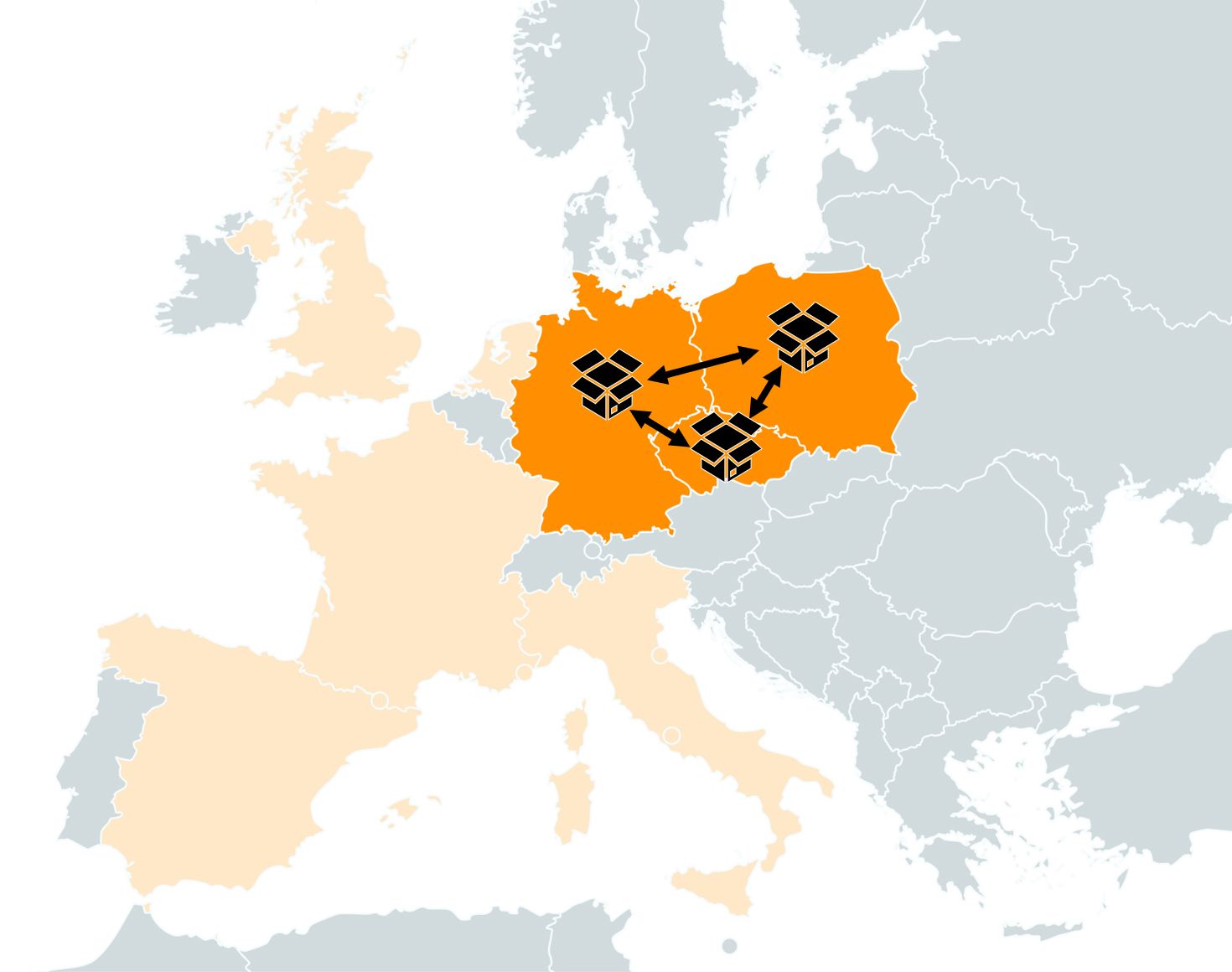
Pan-European FBA (Pan-EU)
"Pan-European FBA" allows you to store your goods in all EU countries where Amazon has a fulfillment center. Amazon distributes and stores your products throughout Europe or in the countries you have enabled for storage. Thus, Pan-European shipping helps you sell your products on all of Amazon's European marketplace sites. You continue to ship the goods to local fulfillment centers only and an algorithm redistributes the goods.
Due to Brexit, Amazon will no longer be able to ship orders with Fulfillment by Amazon across the UK-EU border as of January 1, 2021. To sell in both the UK and EU with shipping through Amazon, you will need to send inventory to logistics centers in both the UK and EU.
"Pan-European FBA" through Amazon gives FBA sellers the ability to store in and sell their products from all European marketplaces. Fulfillment Center is located in Germany, France, Italy, Spain, the UK, Poland, and the Czech Republic.
However, you have to consider tax consequences as you store the goods in more countries. A VAT number is required for each country where you store goods. You will also pay significantly higher removal order fees.
"Pan-European FBA" through Amazon is most suitable for large merchants who sell at least 1,500 units per month. The program offers a variety of benefits: the chargeback of 0.35 euros is waived, shipping to the customer is fast and via Prime, you pay the local shipping costs for all European marketplaces and all export functions are possible.
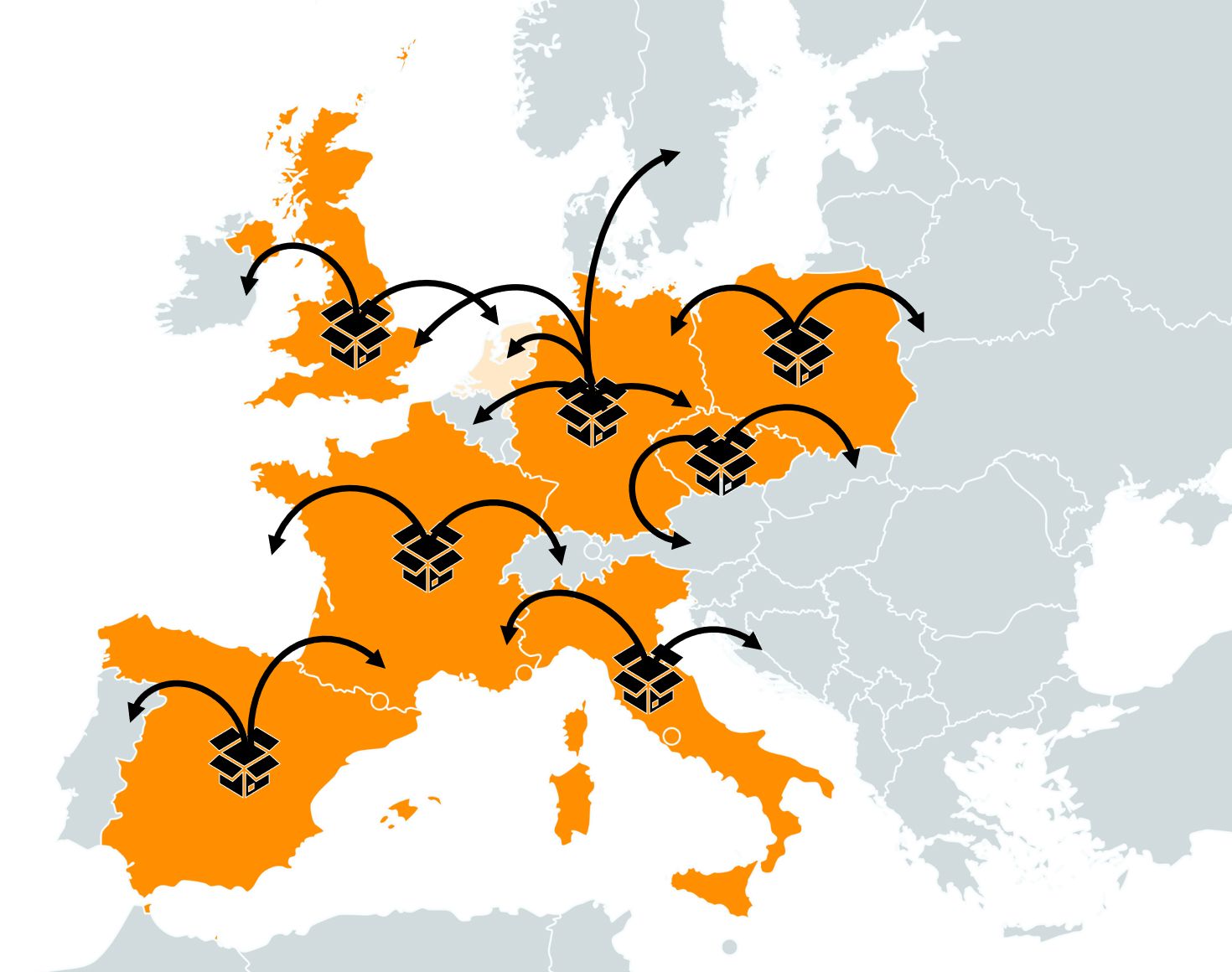
Small and Light
FBA Small and Light is an Amazon fulfillment solution for small, lightweight products priced 10 Euro or less (including VAT). These are deliveries that can be delivered by the mailbox.
For items to be sold in this program, they must meet certain requirements:
- the product must be in "New" condition
- the product must not exceed the maximum dimensions of 33.5 cm x 23 cm x 4.6 cm
- the product must not weigh more than 225 grams
- the product must be priced less than 10 euros
- the product has been bought at least ten times in the last four weeks
Products such as erotic articles, hazardous goods, and temperature-sensitive products are excluded from the program.
One advantage of the program is the particularly low shipping fees. A disadvantage, however, is that you have to pay a penalty fee of 0.25 euros per unit sold to Amazon for local storage.
On Amazon you will find instructions on how to register products for the program and a listing of the program fees.
These are the different solutions you can use with Amazon FBA. Which program you choose depends on individual factors. You have three options where your goods will be stored:
- only in Germany
- in Germany, Poland, and the Czech Republic
- in one or all EU warehouses
As soon as you choose options two and three, you become liable for VAT in the respective country of storage and must pay the VAT rate applicable there, provided you have exceeded a delivery threshold. When calculating the VAT, the decisive factor is the country to which the goods are shipped and the total value of the goods. If the cross-border deliveries to an EU country exceed the delivery threshold in one year, you are obliged to calculate the VAT of the recipient country and pay it there. Since 01.07.2021, there is a uniform delivery threshold of 10,000 euros per year.
Storage fees with Amazon FBA
The storage fees you pay to Amazon for storage in one of the fulfillment centers are independent of the FBA program. The costs are calculated based on the size of the stored goods. To be more precise, the storage fees are calculated based on the daily average storage volume in cubic meters. However, storage costs are not the same in every country. For example, storage in Poland or the Czech Republic is significantly cheaper than in Spain or France.
You pay the storage costs monthly, but only for the days when goods are stored. If you do not have a product in stock at the Amazon fulfillment center for a month, then you will not be charged storage costs. So the total cost of storage depends on how quickly you manage to sell your products.
The storage costs differ according to the low season (January to September) and high season (October to December) and whether an item falls under standard or oversized.
Note
A unit equals oversize if it is heavier than 12 kg, longer than 45 cm, wider than 34 cm or taller than 26 cm. If an item weighs more than 31.5 kg or is longer than 175 cm, you pay a charge of at least 15 euros for shipping by Amazon.
Monthly storage fee per cubic meter:
| Standard Size | clothing, shoes and bags | other categories |
|---|---|---|
| January till September | 15,60 Euro | 26,00 Euro |
| October till December | 21,60 Euro | 36,00 Euro |
| Oversize | all categories |
|---|---|
| January till September | 18,00 Euro |
| October till December | 25,00 Euro |
We explain with an example how you calculate the storage fees:
Let's assume an item that is sold 200 times a month. To ensure that there is always enough merchandise in stock in the Amazon fulfillment center, we want to keep merchandise on hand for 2.5 months, i.e. 500 units. The article has a volume of 0.2 m x 0.2 m x 0.1 m = 0.004 m³. 500 units therefore occupy a space of 500 x 0.004 = 2 m³. If the product is sold in the period from January to September, we have to pay Amazon an average of 26 euros for 1 m³. Therefore, the total storage cost is 2 m³ x 26 euros = 52 euros or 0.10 euros per item.
Long-term storage fee
If you store your products for one year or longer in Amazon's logistics center, an additional long-term storage fee will apply. The storage fee will be charged monthly after one year, in addition to the storage fees. For non-media items, the fee is 170 euros per cubic meter, for media items either the same or 0.10 euros per unit. Media items include books, music, videos, etc.
Fulfillment fees with Amazon FBA
The fulfillment fees you have to pay depends on the dimensions and weight of the item. In addition, Amazon differentiates whether the item is a media or non-media item. The larger and heavier the products are, the more expensive the fulfillment fees will be.
Amazon calculates the fulfillment fees for each shipped item individually. For example, if a customer orders four units of the product, you will have to pay the same fulfillment cost as if four different customers order the item.
Example shipping costs:
| Product | Dimensions | Weight | Fulfillment fees |
|---|---|---|---|
| Standard Size, small envelope e.g. SD card | 3,2 cm x 2,4 cm x 0,2 cm | 30 g | 1,73 Euro |
| Standard Size, large cover e.g. book | 24 cm x 16,2 cm x 3,5 cm | 150 g | 2,40 Euro |
| Standard Size package | 37 cm x 15,4 cm x 7 cm | 590 g | 3,38 Euro |
On Amazon you can find a table for calculating the shipping fees.
Shipping and Export settings
Amazon allows sellers to sell to customers outside of the listing marketplace. Amazon differentiates between storing goods in different countries, as well as shipping across borders and exporting worldwide. Depending on how you set it up in the settings, a customer can buy it on amazon.fr and have it shipped to Spain. You can set Amazon for each marketplace separately, where goods are stored, and to which countries they should be exported. There are no additional costs for exporting orders besides the existing fulfillment fee.
If you click on "Fulfillment by Amazon" under "Settings", you will see the fulfillment programs and export settings:
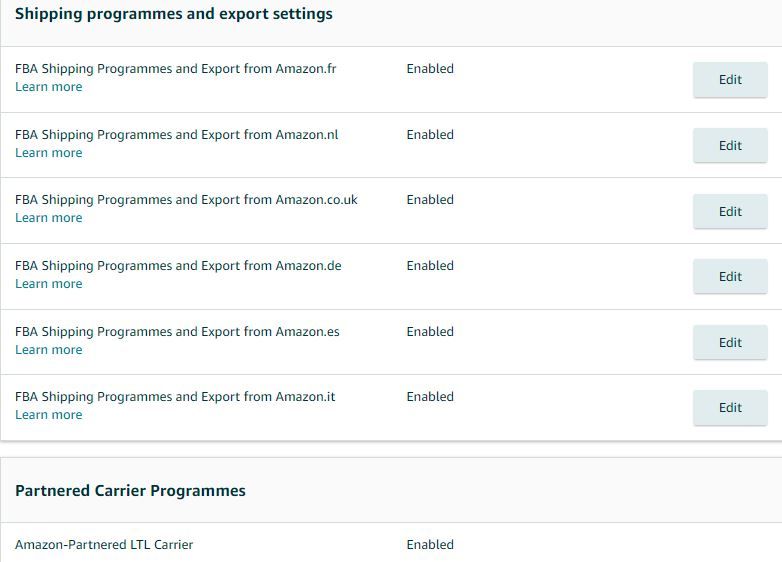
There are two options for each marketplace: Disable shipping and export abroad or import worldwide to over 80 countries:
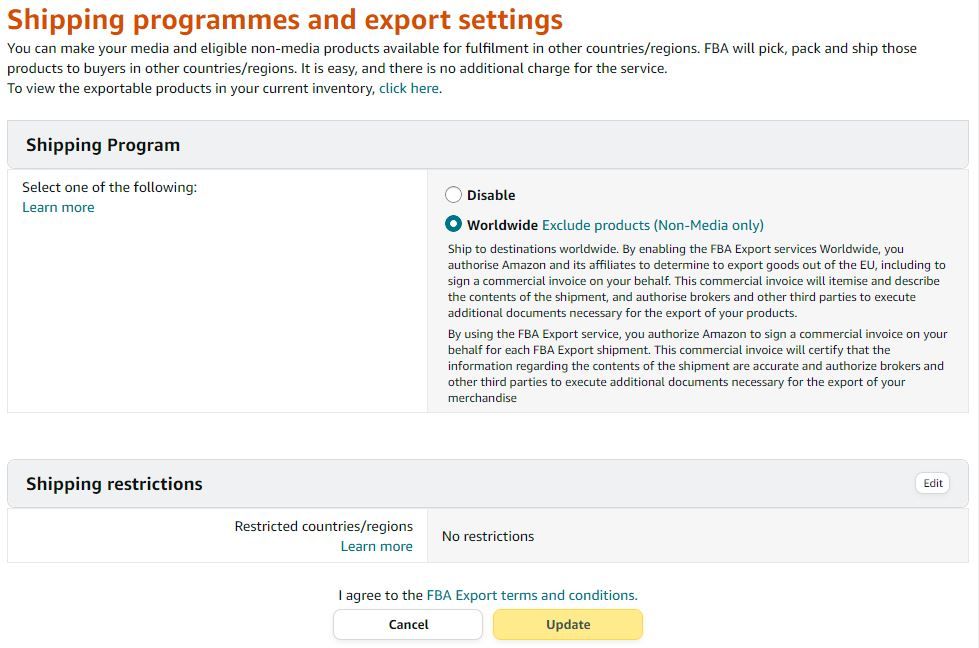
You can also define shipping restrictions for specific regions for all items:
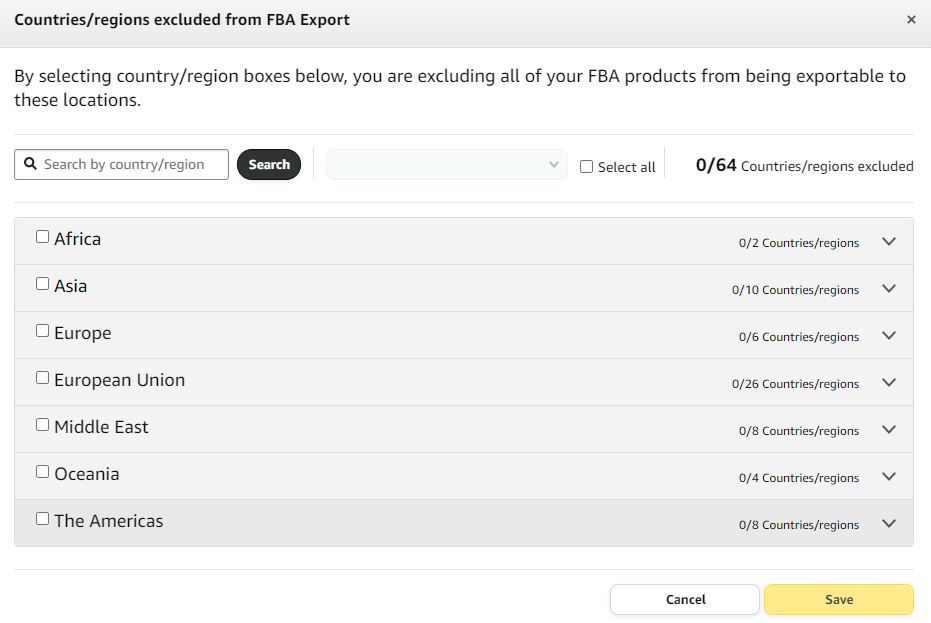
FBA customer returns
When a customer returns an item, Amazon handles the entire return process. You will not notice much about a return, except that "Refund requested" will appear in the overview of your orders for an order. Click on "Manage orders" under "Orders" to get to the overview.
A customer can request a refund for a variety of reasons, and in most cases, the refund is free to the customer. In the case of a return, Amazon will process the purchase backward in the background: Amazon will deduct the sales from your account and retain 20 percent of the sales fee. Click on "Payments" under "Reports" and then on "Transaction View", so you can see exactly which amounts Amazon reimbursed you first and deducted again later.
Refurbishment Service:
Amazon offers for returned products that are not in resalable condition, the so-called “FBA repackaging and refurbishment service”. In this process, Amazon restores returns to a saleable condition, provided the units require only minor refurbishment. For example, if a customer returns a product and damages the packaging or leaves fingerprints on the product, Amazon will clean the product and repackage it. Under "Settings", click "Shipping by Amazon" to enable or disable the refurbishment service.
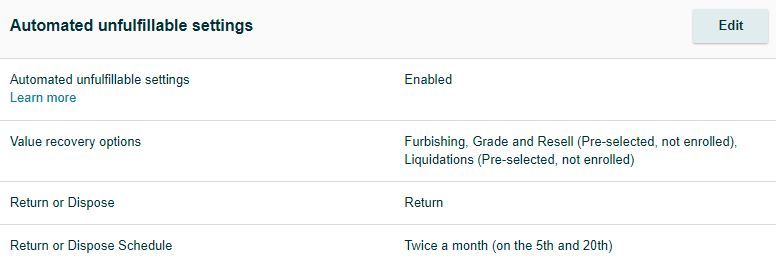
FBA Removal:
If Amazon deems a returned item "no longer suitable for sale," you must either take it back or have it destroyed. Now there's the difference of who takes responsibility for an item's condition. Amazon will take responsibility for items that are damaged or lost in the fulfillment center or during the shipping process. In all other cases, you have to pay the return cost and take the items back. If Amazon deems the returned item to pose a safety, health, or liability risk, Amazon will destroy the items.
A customer has up to 30 days from the date of purchase to register an item for return on Amazon. After that, he has another 15 days to ship it to Amazon. So, in total, it can take up to 45 days for Amazon to receive a returned item back. Amazon usually has a very customer-focused attitude and will often not take responsibility for a defective item brought on by a customer.
Cost of Return and Disposal:
The cost of removal depends on the weight, size, as well as where the item is stored. A domestic return costs about 0.50 euros, whereas returns from abroad cost about 5 euros. The disposal of the item is also calculated according to weight and size. There is 0,25 Euro for very light and small and 3 Euro plus 0,40 Euro per additional kilogram of weight from a weight of more than 5 grams.. Here → you will find a price list in which the costs of return and disposal are listed.
Prepare shipment to Amazon
After you have decided on a fulfillment program, you still need to send the goods to an Amazon fulfillment center for storage. Note that you may not ship all products through Amazon FBA.
Prohibited items under the Fulfillment by Amazon program include:
- Vouchers or prepaid cards that represent a monetary value
- Products containing nicotine
- Firearms, firearm parts, ammunition, or other weapons
- parts of animals
- used vehicles and parts
Go to Amazon for the complete listing.
Inventory Planning
On the one hand, as a seller, you always want to ensure that each of your products is available at all times. On the other hand, you want to reduce the volume of stored goods to a minimum to keep storage fees as low as possible.
Click on "Inventory Planning" under "Inventory" to get information about currently too low or too high inventory levels.
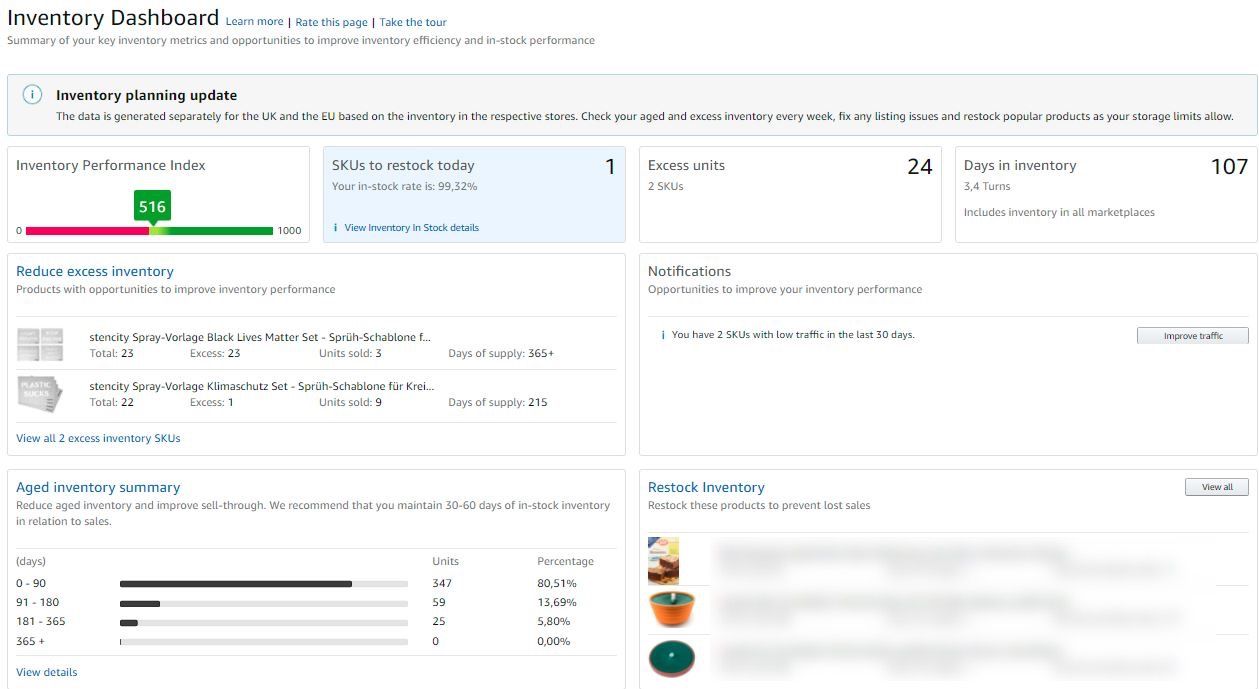
Here you can see which products are overstocked, which products should be reordered and an overview of the old stock in the warehouse. You can get more details on these items in the tabs of the same name.
For each seller, Amazon determines an Inventory Performance Index (IPI). This calculates how well you keep products in stock with a high throughput rate, maintain an optimal inventory size from Amazon's point of view, and solve problems with your (over)offers. The IPI thus shows you how efficiently and productively Amazon rates your inventory management. Under "Inventory", click "Inventory planning" and then "Inventory performance" to get a detailed breakdown of the IPI:
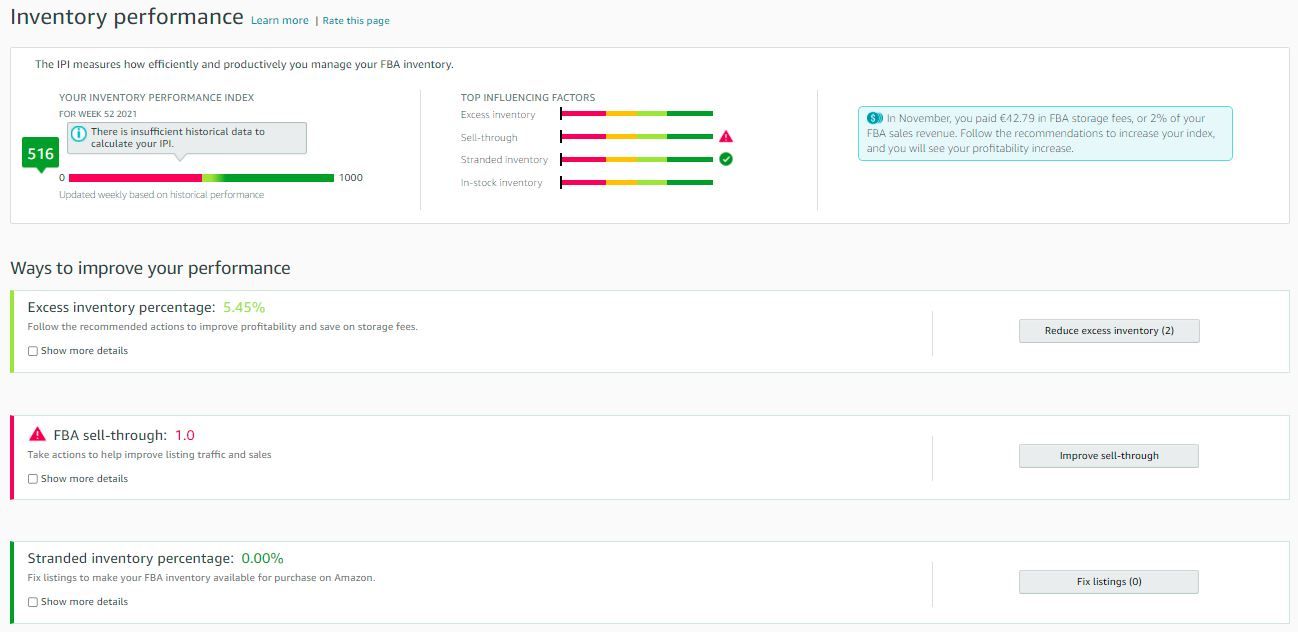
To the right of the index, Amazon shows you the current costs for storage at Amazon. This gives you an overview of the ongoing costs that are incurred. Likewise, you can derive concrete measures to improve the stock. For example, if you have a poor sell-through rate, you should generate more page views through advertising.
The IPI takes a value between 0 and 1,000 and is recalculated weekly. Amazon lists four important factors influencing the index:
- Overstock: how many units will foreseeably remain in stock?
- Sell-through: how quickly can you turn over your FBA merchandise?
- In-stock inventory with no active listing: how much merchandise can't be sold due to listing issues?
- In-stock inventory: how often can you not fulfill orders due to lack of inventory?
Prepare shipment to Amazon
Before you send a product to Amazon, it must not only be correctly created in the catalog but also physically meet certain requirements.
FBA product barcode requirements:
Every item that will be stored on Amazon must have a scannable barcode. Which barcode you qualify for depends on whether you allow Amazon to mix your products with like products from other sellers. With so-called "mixed inventory", Amazon stores similar products from different merchants in one storage bin. If you use the "mixed stock", you have to attach an original barcode (EAN, GTIN) to the packages. If you decide not to use the "mixed inventory", each product must carry the barcode defined by Amazon based on the FNSKU (Fulfillment Network SKU) belonging to the product. Amazon still assigns a unique designation for each SKU so that the product can be identified in the warehouse. The SKU is determined by you, the FNSKU is determined by Amazon.
To save yourself the work of labeling, we recommend that you have the appropriate barcodes applied directly by the manufacturer as part of the manufacturing process.

Packaging of Products:
Once you send goods in cartons to Amazon, whether as a parcel shipment or palletized, these shipments must meet various requirements:
- use cartons that can survive the transport route undamaged
- a carton must not weigh more than 23 kg (otherwise it falls under oversize). cartons weighing more than 15 kg must be marked with stickers with the inscription "Heavy" on each carton side
- do not glue several cartons together or attach carrying aids
- mark each carton with a shipment ID
- pack the goods securely with filling material
Shipping via freight forwarder:
Above a certain quantity, shipping goods in cartons is no longer efficient to handle. To ship large quantities, they are usually transported on pallets. These are transported in a truck and therefore you often read about LTL shipping (Less Than Truckload, i.e. partial truckload) or FTL shipping (Full Truckload, i.e. complete truckload). To ship such a shipment to Amazon, you must meet the following requirements:
- the shipping weight must be 75 kg or more
- the shipment must be on a standard pallet that meets DIN 15146 and is marked with "EPAL" or "EUR
- if you send more than one pallet, each pallet must contain the number of the pallet and the total number of pallets (e.g. pallet 3 of 4)
- pallets must have pallet labels on all four sides
- the shipments on a pallet must be secured with stretch film
- the maximum height of a pallet shipment is 1.8 m including the pallet, the total weight must not exceed 500 kg
- the goods may protrude max. 5 cm on the sides
- each shipment must be accompanied by a consignment note
For each delivery, the carrier must arrange a delivery date with the respective distribution center in advance. Amazon provides the Carrier Central portal for carriers to register and book a delivery appointment.
Amazon and Partnered Carrier program:
Amazon has launched a partner program with certain transportation providers. With the partner program, ready-made shipping labels for cartons or partial truckloads can already be created in Seller Central. The program is available for cartons for the service providers DHL, UPS, and pallets for the forwarders UPS Freight and Kühne + Nagel. In Seller Central you can get more information about the Amazon Transport Partner Program.
Create an Amazon FBA shipping plan
By setting up your Amazon shipping plan, you are telling Amazon exactly how much of your specific products will ship from which location before they arrive at Amazon's warehouses. You have three options for creating a delivery schedule:
Create shipments to Amazon in Seller Central.
Go to "Inventory", then to "Manage FBA Inventory", and there select the products you want to send to Amazon. Then above the table, under "Actions", select "Send / Replenish inventory". At this moment Amazon automatically creates a new shipping plan that already contains the selected products.

Under "Inventory", click "Manage FBA Shipments" to upload a delivery schedule or edit a delivery schedule afterward.
Send to Amazon.
Under "Inventory", click "Manage FBA Shipments" and click "Send to Amazon" at the top. The delivery schedule is divided into three or four steps:
- Step 1: This is where you specify the address you are shipping your product from and the marketplace the product is destined for. You also specify which product you are sending to Amazon
- Step 1b: this step is not about the packaging of the product, but about the shipping box. You will specify the units per carton, dimensions, and weight.
- Step 2: here you first enter a shipping date. Based on this, the system will try to determine a shipping partner and calculate the cost of shipping. You also determine whether the goods will be sent as a parcel or as a pallet shipment.
- Step 3: here you will see a summary of your shipment and you can print the shipment labels
Send / add stock (conventional way)
Under Inventory, click on "Manage FBA Inventory" on the appropriate product and select "Send / Replenish inventory" by highlighting it or using the dropdown menu under "Edit".
Amazon will then guide you step-by-step through creating a delivery schedule. You first enter the sender address and the products with quantities. In the next step, you select the products you want to deliver and specify per SKU the quantity you will send to Amazon. In the next step, Amazon will ask if the products need any specific preparation (for example, fragile products need to be repackaged again). After that, you choose the appropriate labeling. If the manufacturer already labels the package with a barcode, then you or Amazon don't have to do anything else. In the next step, you will see which items will be delivered and where the shipment has to be sent to. Then you will receive all the important information about your shipment and you have to specify in which form and with which service provider you want to send the goods to Amazon.
Hazardous materials
All products that contain flammable, pressurized, corrosive, environmentally hazardous or otherwise dangerous chemicals are labeled as "hazardous goods" in the EU.
If you would like to ship such an item to Amazon, you must follow some guidelines: You must provide product safety information on the product's product detail page and include the appropriate hazard pictograms.
Amazon allows certain dangerous goods to be shipped with Amazon FBA.
The following hazardous goods are permitted:

The following hazardous goods are permitted on a limited basis:
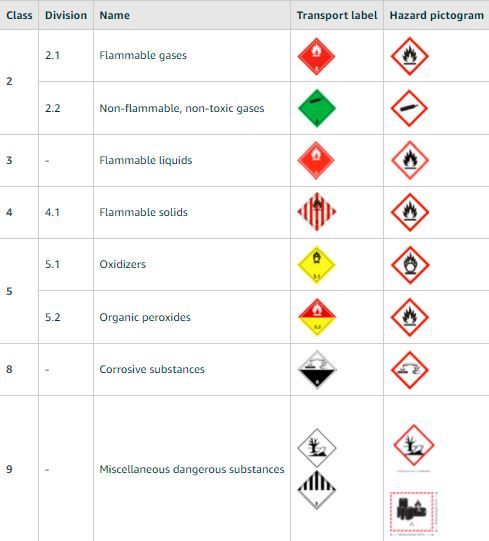
The following dangerous goods are not allowed:
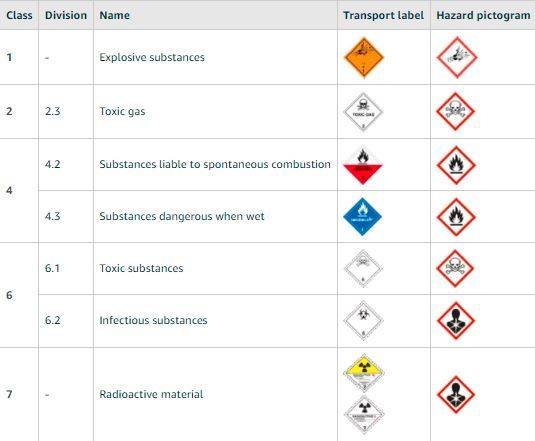
If you are sending shipments to Amazon, you must specify for each shipment whether it is a dangerous good. Be as specific as possible with all data, such as what batteries your product contains. On this page Amazon has summarized the dangerous goods classification process. You can get an overview of the classification status and submit documentation.
Monitor Amazon FBA with AMALYTIX
Monitoring your inventory, monthly storage fee, and other metrics related to Amazon FBA is critical to your success on Amazon. Our Amazon Seller Tool and Amazon Vendor Tool AMALYTIX makes this possible.
In AMALYTIX we show you various key figures about your stock in the Amazon fulfillment center. For example, you control which items are offered on which marketplaces, the number of products currently in stock, the number of items in delivery at the FBA warehouse, and much more. We check daily to see if anything has changed. If anything has changed, you will automatically receive a notification and thus keep a full overview every day.
Conclusion
Amazon selling partners have two options to offer their goods on the marketplace: FBA and FBM. Fulfillment by Merchant means that the seller independently takes care of the goods storage and shipping. Amazon merely serves as a platform for offering goods. Fulfillment by Amazon means that Amazon merchants completely outsource the storage of the goods and the shipping of the goods to the customer to Amazon for certain fees. You send your products to an Amazon fulfillment center and Amazon takes care of the rest.
Merchants who opt for "Fulfillment by Amazon" can focus on other tasks, such as developing or marketing products. If you use Amazon FBA, it is important to find a suitable product. The selection should be made carefully, and the performance of the products should be checked and estimated in advance.
"Fulfillment by Amazon" is a good solution for online retailers who want to grow in Europe and outsource as much work as possible. The costs are usually manageable and the potential should not be underestimated. FBA sellers not only benefit from cheap storage, but the items also get higher visibility and a Prime certificate on Amazon. Customer satisfaction increases, due to free shipping and short delivery times. Therefore, it becomes difficult for non-FBA merchants to compete with FBA sellers in the long run, at least when it comes to the same or similar product.
